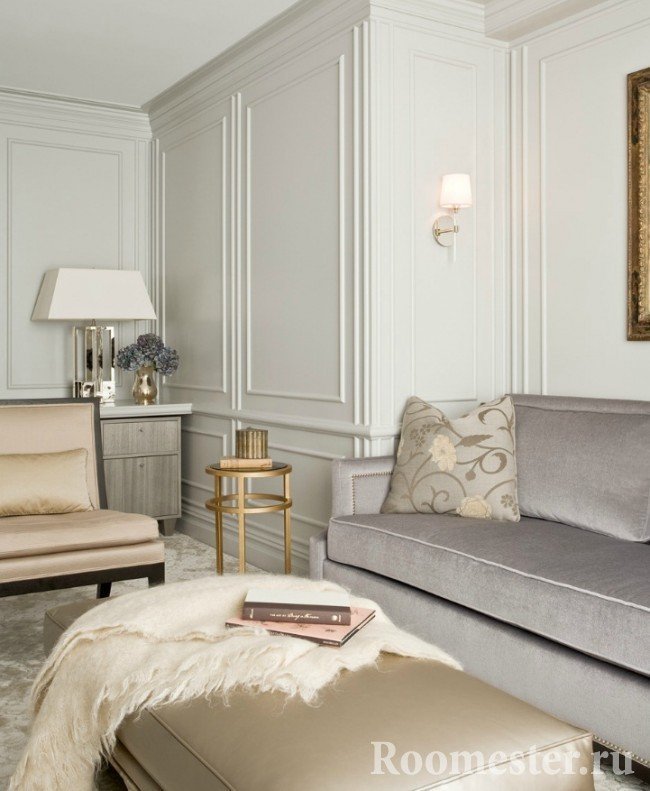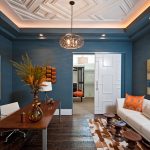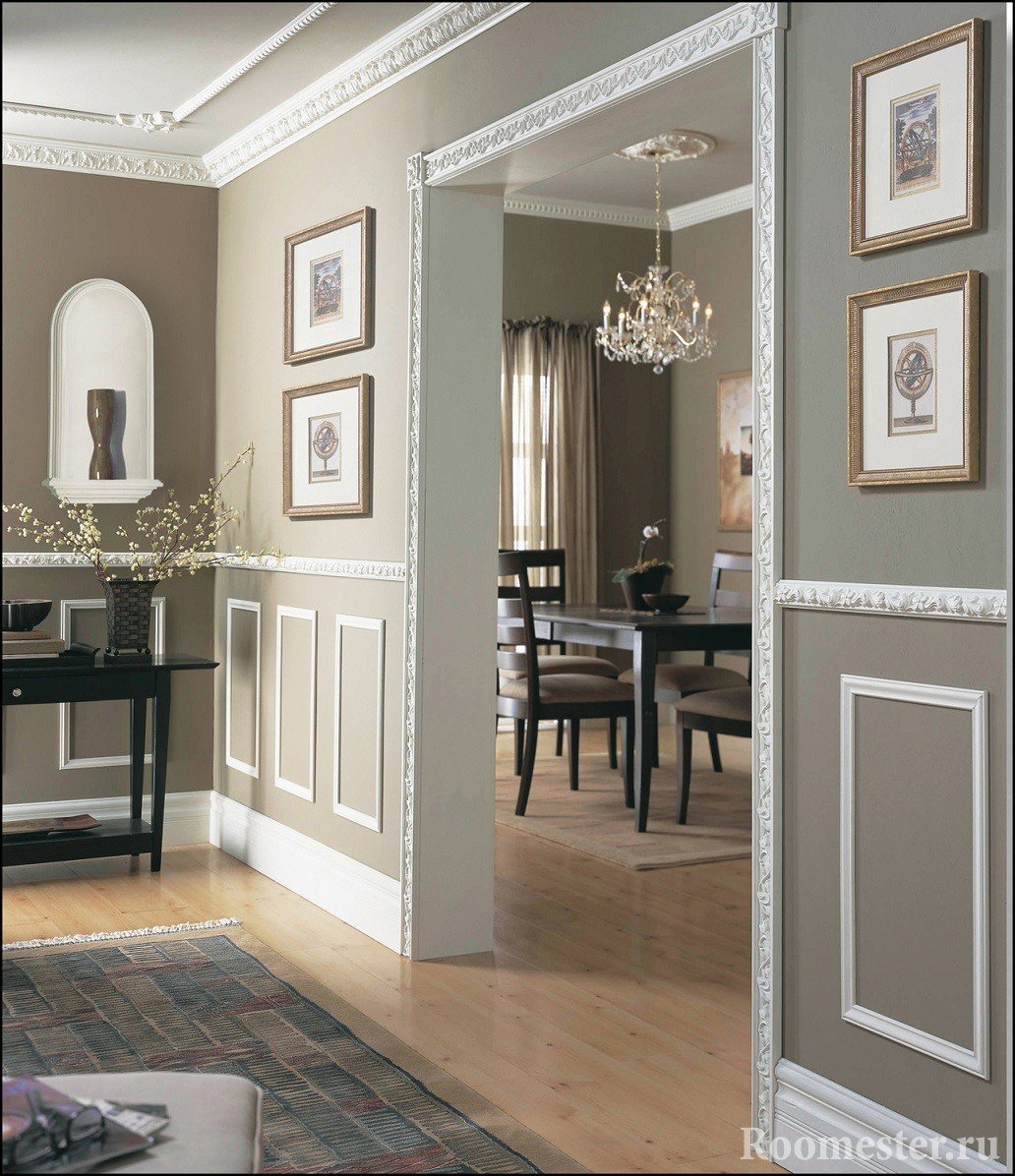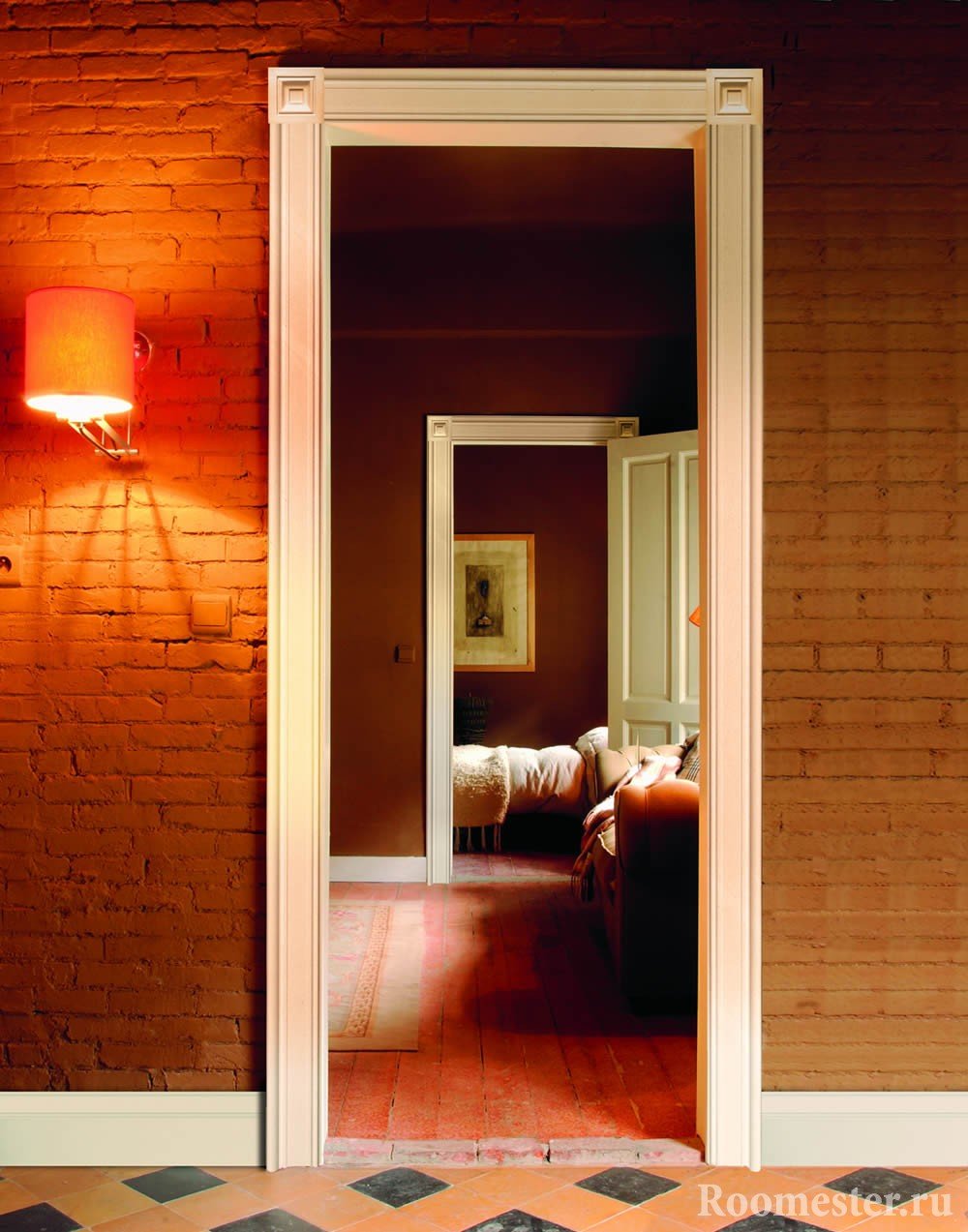There are many design techniques and tricks with which you can change the visual perception of the room. Most methods involve skillful, appropriate placement of decorative elements. The use of moldings is gaining great popularity. Using these decorative elements, you can achieve a significant change in the space in the living room, hall, office space.
Moldings in the interior have been used for a long time, for example, when decorating the palace halls of the pompous Rococo style. Modern designers use them to achieve the finished look of the room when creating classic, neoclassical interiors. This element is widely used in the design of windows, walls, ceiling surfaces. In addition to aesthetic functions, it can protect surfaces from damage, hide existing wall imperfections.
Varieties
Molding is a three-dimensional relief strip that is mounted on the surface of the walls, ceiling, around the door, window opening. The element has a length limit (2 m), but can be of different widths, shapes, contents.
The material of manufacture can be varied, the following types are often used:
- polystyrene;
- plastic;
- polyurethane.
Decorative elements made from these materials are durable, easy to install and maintain. Rare cases require the use of overhead elements made of wood, natural stone, gypsum. Such material is much more expensive, more difficult to work, requires careful care. Panels made of stone or wood are widely used in the restoration of historically significant objects, while maintaining authenticity.
When using moldings made of natural materials in private houses, apartments, the complexity of care must be taken into account. Materials are very whimsical, require certain environmental conditions. For example, wooden overhead elements quickly lose their shape, color, other aesthetic qualities with high humidity. Color overlays and inserts of bright tones gain unprecedented popularity. They should be used more carefully, it’s very easy to cross the line and the interior will become ridiculous.
The concept of molding includes: stucco molding, plinths, frames, planks, profiled panels. In a section they can have a flat look, carved or convex. They can be equipped with many small stucco details. Even the ceiling frame, which makes a smooth transition from the wall, can be considered a molding. Colored moldings are used to focus on individual details of the decor, dividing the space with different textures.
Most often, the molding is simply attached to a specialized glue or self-tapping screws that are masked with putty.Fastening with screws is used when the molding is made of heavy material or fastening in other ways is impossible. The choice of molding depends on the general style and decor of the interior. The style of the interior can be either classic or close to modern or urban.
Moldings are a simple, affordable, original way of managing space, while creating an authentic atmosphere.
Wall decoration
Wall moldings can be used in many cases. This is a great opportunity to visually expand, increase the space or its separation. A modern interior can include many textures and combine wall decoration with wallpapers of different colors, a combination of wallpaper and paint in separate areas. It is for separation and a smooth transition from one zone to another that this type of decor is used.
The moldings on the wallpaper can serve not only as a separator, they can also hide flaws, errors of unsuccessful repairs and uneven walls. Successfully and competently located decor is able to stretch the space, smoothing out irregularities. Molding is rarely used in a single case, often it is a whole composition of frames or harmoniously interwoven planks. If space allows, then the moldings can be placed symmetrically on certain sections of the wall, it looks beautiful and expensive.
Using this decor tool, you can visually extend the room, this technique is used in rooms with low ceilings. To do this, the elements are vertically inserted into the place where the wallpaper is connected with a different pattern, color, texture. This will emphasize the rest of the decor, which is located next to the transition point and add a feeling of high ceilings to the room.
Moldings can be used in any room: hall, nursery, bedroom, kitchen or dining room. For the bedroom, pastel and narrow moldings are more suitable, while in the nursery you can play with the texture and relief and create a fabulous atmosphere. When decorating the walls, it is important not to overload the interior. The finished look of the room should be concise and restrained.
With inept use of false decor on the walls - it is easy to spoil and distort the room. It is also necessary to understand that when composing a composition from frames or repeating motifs, they should be identical in size and should be located at the same distance from the ceiling, floor or window.
The moldings on the walls look expensive and pompous, this should be taken into account when decorating rooms with a small area, because it is not recommended that they be overloaded with a large amount of decor and auxiliary elements. In this case, a combination of different texture of wall decoration, separation of wallpaper moldings would be ideal. This will fill the room with additional volume.
When combined in the design of panels in combination with paint on the walls or wallpaper, molding can emphasize the separation, perfectly fencing different materials. You can also apply it otherwise - smooth and make a smooth transition, you can make an almost imperceptible transition.
From the molding you can make certain repeating sections. This technique is relevant in rooms with high ceilings and light walls. To some extent, the traditional use of molding on the walls is the formation of rectangular compartments from it. You can use curved molding to form arches and simulate a window opening. This technique is suitable for bedrooms or living rooms in the Renaissance or neoclassical style.
This element is widely used in the decor of a children's room. A good frame comes out of it for photo frames, mirrors, bookshelves. Wallpaper with printed planks in the bedroom interior looks spectacular; on the background of light walls, you can make several sections that differ in color, texture and frame them with subtle restrained planks. Allowed the placement of stucco elements, other surround decor in the middle of the composition.
When decorating the walls, moldings of any kind, width, color scheme are used.It is recommended to prepare the layout and size in advance. You can mark the walls with a simple pencil or chalk.
Framing windows and doors
In modern apartments, the windows are not always high and large. You can give a feeling of free space and visually increase the area of the window with a molding. For a low and narrow window, a concise and wide finish is perfect. On large windows, you can use moldings with many decorative inserts and stucco elements.
Planks, skirting boards make out the space around the window opening, it can be a symmetrical arrangement or underlining a certain area of the window. When decorating a window with a molding, it is not recommended to use bright colors, to combine different types of planks, profiles, this will close the space around, attract extra attention to the window. Moldings with stucco moldings look chic on the panoramic windows; they really can create the impression of being in an old castle in the south of France. The decor around the window opening should be in harmony or exactly match the color of the frame on the window. A technique is often used in which the molding on the windows repeats the pattern, motif, and relief of the frame of the doorway.
Often in the interior molding is used as a platband on the door. This is a great way to divide a room that has only a doorway or arch. In this case, overhead elements of different colors can be used for a greater emphasis on different parts of the room. This decor can both increase the size of the doorway and, if necessary, make a smooth transition.
This is necessary in cases where you need to hide the doorway. In addition, decorative strips made of durable material are often used as a protective mechanism for individual sections of the room. This may be relevant in the absence of a door lock, when the door handle hits the wallpaper.
Ceiling or floor skirtings protect the walls from mechanical damage by furniture parts. When placing a double strip of moldings under the ceiling, you can significantly increase the height of the ceiling and add free space to the room. One bar should go along the extreme line of the wall near the ceiling, the second is placed 10-20 cm lower.
If you want to visually increase the height of the ceiling, the molding must be glued strictly parallel to the level of the ceiling angle. With a wider upper strip, the impression of an arched vaulted ceiling is created.
Unconventional use of molding
In addition to the above methods, moldings can be used not quite in the traditional sense. Out of this material strange shelves for books or other trifles are obtained. For these purposes, a wide, convex plank of small length is used. It can be single copies, it can be a composition, for example, in the corner of a room. This solution looks aesthetically pleasing, saves space. For example, shelves for books, you can equip places for photos, small flower vases, a place for keys.
The molding is framed by hidden safes or household appliances. Plasma TV, which can stand out against the background of the interior style, can transform a pair of horizontal specialized profiles. There is a tendency to decorate furniture sets, the end parts of beds, and the backs of chairs with moldings. The molding is mainly used from noble wood species, less often - plastic, foam with imitation wood.
A separate type of molding is metal, imitating silver, gilding, bronze. Let's accept use in expensive, magnificent interiors. Fireplaces, large mirrors, columns with decor with wide, carved gold planks look spectacular in these rooms.
The choice of color, texture, molding material is a process that requires the consultation of a specialist, a design team.With complete self-confidence, you can try to do it yourself.
Important points to consider when decorating a room with a molding:
- area of the room;
- wall decoration material;
- the presence of other decorative elements;
- familiarization with visual aids (photos, videos) on working with moldings;
- space for free mounting / dismounting of strips.
You can take a photo of the interior, then mark the location of decorative elements on it. This technique will help save time, make accurate calculations of the amount of material needed.
When calculating the amount of material required, it is worth considering a small margin. A larger margin should be made when using moldings made of fragile, lightweight material. The installation process involves possible chips, cracks, breakdowns. Using patch panels in a light shade, it is worth choosing materials that can be washed. Most of them are specially impregnated with a specific solution that repels dust and does not absorb odors.
In skilled hands, molding can become a subtle tool for improving the space in the room, its division, increase the area. Molding can be successfully used in residential buildings, apartments, offices, commercial buildings. The main rule is to know the measure. A pair of unsuccessful slats can turn an elegant interior into an absurd angular room. With a successful combination of molding, decorative wall elements, the room is transformed, it becomes light, airy. Ideas for inspiration can be gleaned from glossy magazines, design publications, and see photos of finished interiors. The key to beautiful design is a well-thought-out plan for the placement of decorative elements.









































Very helpful.The ideas are non-trivial, easy to remember and presented in a pleasant manner. I liked both the site and the video at the end, the music is wonderful, by the way. Useful site in general. Thanks.